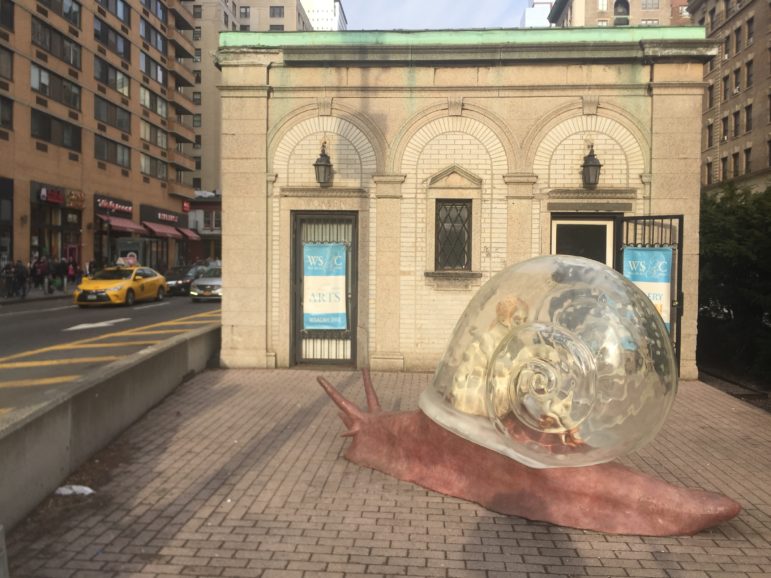
Rosemary Misdary
It's not a bathroom or an entrance to the subway. It's the West Side Arts Coalition, where everyone can be an artist.
Behind a giant snail with a transparent shell is a small Beaux-Arts building on the Broadway mall at 96th Street. The word “women” carved above its west door is a hint at the building’s past life.
“Most people wander in here because they think it’s a bathroom or the subway,” says Georgiana Grantham, an abstract painter and board member of the West Side Arts Coalition, which leased the space from the city after it was transformed from a public bathroom into a gallery in 1986. “Then they realize they are in an art gallery, and they get curious and look around.”
The West Side Arts Coalition is an artist-run gallery that has endured for 40 years and is thriving even as the number of art galleries in the city has declined over the past decade. A recent report by investment bank UBS and the art fair Art Basel found that worldwide more galleries are closing than opening compared to 2007 when five galleries opened for every one that closed.
Grantham credits the coalition gallery’s survival to its inclusive philosophy and financial independence. She says it accepts all artists regardless of training, style or medium and doesn’t require an interview or portfolio review. It’s a place where the work of Robert Scott, 84, a trained abstract painter, hangs alongside that of Grantham, 67, an artisan in the midst of teaching herself to paint.
Anne Rudder, the group’s president, says artists are only required to fill out an application and pay an annual fee of $60 ($25 for students). The dues from its 85 members is enough to keep the lights on and pay rent that the president described as “not much” to the city.
Margo Mead, vice president, says the coalition carries on without outside funding because its active membership, almost two-thirds women and one-quarter artists of color, provide what the annual fees don’t cover.
“When we put up a show, it’s the artists helping to hang the paintings,” says Mead. “It’s the artists who greet the people when they come in. They bring the food for the reception. That’s how it’s been.”
This arrangement and the rent break from the city have allowed the coalition to succeed while others are failing.
Shazzi Thomas, director of The Painting Center, a 25-year-old nonprofit membership gallery located in Chelsea, says four galleries have shut down this month in her building.
“Rents are rising,” says Thomas, who considers her gallery’s $9,000 monthly rent reasonable. “Eventually we will get priced out. We don’t know how long we will be here.”
The subsidized rent allows the West Side Art Coalition’s members to focus on creating art and have a place where people can see it.
“Applying for grants and funding is a big full-time job,” says Rudder. “We don’t have the time. We’re making art and showing it.”
Mead, a trained watercolorist, says that she was snobbish and skeptical at first. Before she joined, she passed the gallery frequently and never went inside because she thought that it probably did not have any serious art because it was inclusive. She says being a member has helped her connect with the true purpose of creating.
“People come in here and over and over and never buy,” says Mead. “I don’t care. People appreciating art is what brings me joy.”
Lingering before a folk art painting of a runaway bride smoking a cigarette in a swamp, Barbara O’Malley, a second-time visitor, was excited about the current show, whose artists include her friend Robert Scott.
“I found the gallery because of an artist friend,” says O’Malley. “But I am so captivated with the other work showing.”
City Limits’ reporting on the intersection of art and policy is supported by the Laurie M. Tisch Illumination Fund. City Limits is solely responsible for all content.









One thought on “As Galleries Shut Around NYC, an Inclusive Outpost Somehow Survives”
I’m a writer and I live in the neighborhood. How does one become a member of the Westside Arts Foundation?